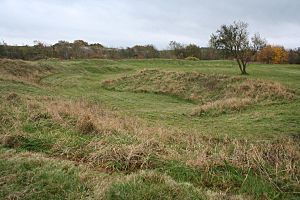The Bull Ring facts for kids
 |
|
| Location | Dove Holes |
|---|---|
| Region | Derbyshire, England |
| Coordinates | 53°18′2.5″N 1°53′3.92″W / 53.300694°N 1.8844222°W |
| Type | Henge (Class II) |
| History | |
| Periods | late Neolithic |
| Site notes | |
| Condition | some damage |
| Official name | Bull Ring henge, oval barrow and bowl barrow |
| Designated | 26 November 1928 |
| Reference no. | 1011204 |
The Bull Ring is an amazing ancient site in Derbyshire, England. It's a special type of monument called a henge. People built it a very long time ago, during the late Neolithic period. This was the New Stone Age, when early humans were starting to farm.
The site is near a place called Dove Holes. It's a protected historical spot, meaning it's very important to keep safe.
Contents
What is a Henge?
A henge is a circular earthwork. It usually has a ditch inside a bank. Think of it like a big, round fence made of earth. People built henges for different reasons. They might have been used for ceremonies or gatherings. The Bull Ring is a "Class II" henge. This means it has two entrances.
Exploring the Earthworks
The Bull Ring henge is a large, circular area. It measures about 53 meters from north to south. It is 46 meters from east to west. The outer bank is about 1 meter high today. It was originally taller, around 2 meters high. The bank is about 9 to 11 meters wide.
Inside the bank is a ditch. This ditch is currently about 0.5 to 1 meter deep. It is also 8 to 12 meters wide. When it was first built, the ditch was deeper, about 1.2 to 2 meters deep. A flat area called a berm separates the bank and the ditch. This berm was originally about 5 meters wide.
The henge has two entrances. One is on the north side, and the other is on the south. Each entrance has a path, or causeway, that crosses the ditch. In the 18th century, the middle of the henge was plowed. A stone wall was also built across the site.
Digging Up the Past: Excavations
Archaeologists have explored The Bull Ring many times. In 1902, a small dig happened in the west ditch. They found pieces of pottery and flint. These items helped them learn about the people who used the henge.
Another important excavation took place in 1949. This dig confirmed the henge has two entrances. It also gave clues about the original size of the bank and ditch. More flint pieces and a pottery rim were found.
In 1984, another excavation happened outside the south entrance. This team found more flint and pottery. They also found pits and holes from a fence. These might have been part of the original henge. More recently, in 2000, scientists used special equipment. They tried to find more hidden features underground.
Nearby Ancient Burials
Close to The Bull Ring henge are two ancient burial mounds. These are called barrows. One is an oval barrow, and the other is a bowl barrow.
The oval barrow is about 27 by 21 meters. It stands about 2.5 meters high. People built this barrow even earlier than the henge. It dates back to the early or middle Neolithic period. Later, a bowl barrow was built on top of it. This happened between the late Neolithic and late Bronze Age.
During World War II, the top of the oval barrow was disturbed. Farmers also plowed near its edges. A stone wall was built there too, but it has since been removed. Archaeologists have not yet excavated these barrows. They hold many secrets about ancient times.

